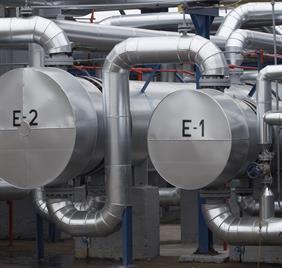Heat exchangers are essential parts of many industrial processes. The double pipe heat exchanger is one such adaptable design. These gadgets are essential for moving heat from one fluid to another and regulating temperature in a variety of applications. We will delve into the world of double pipe heat exchangers in this blog, looking at their design, operation, benefits, drawbacks, and the many industries that use them.
What Is a Double Pipe Heat Exchanger?
A double pipe heat exchanger, often referred to as a tube-in-tube heat exchanger, is a simple yet effective design used to transfer heat between two fluid streams. It consists of two concentric pipes—the inner tube carries one fluid, while the annular space between the two tubes accommodates the other fluid. Heat transfer occurs through the inner tube’s wall.
Working Principle of Double Pipe Heat Exchanger
The working principle of a double pipe heat exchanger is straightforward. Heat is transferred from one fluid to another through the pipe walls. Here’s how it typically operates:
- Hot and Cold Fluids: The hot fluid enters the inner tube, while the cold fluid flows through the annular space between the inner and outer pipes.
- Heat Transfer: Heat from the hot fluid flows through the inner pipe’s wall and into the cold fluid, causing the cold fluid to heat up.
- Counterflow or Parallel Flow: Depending on the arrangement of the pipes, the heat exchanger can operate in counterflow or parallel flow.
Advantages of Double Pipe Heat Exchangers
- Simple Design: The design is easy to understand and cost-effective to manufacture.
- Compact Size: Double pipe heat exchangers are compact, making them suitable for space-restricted environments.
- Ease of Cleaning and Maintenance: Their simple construction makes them easy to clean and maintain.
- Adaptable: They can handle a wide range of fluids, pressures, and temperatures.
- Cost-Effective: Double pipe heat exchangers are economical, particularly for small to medium-scale applications.
Disadvantages of Double Pipe Heat Exchangers
- Limited Heat Transfer Surface: Due to their compact design, double pipe heat exchangers may have limited heat transfer surface area, making them less suitable for high-capacity applications.
- Pressure Drop: They can experience a significant pressure drop in the flow, which may require additional pumping power.
- Low Efficiency: In some cases, their efficiency may be lower compared to other heat exchanger types.
Applications of Double Pipe Heat Exchangers
Double pipe heat exchangers are used in a variety of industries due to their versatility. Some common applications include:
- Chemical Industry: These heat exchangers are used in chemical processing for temperature control and to facilitate chemical reactions.
- Pharmaceuticals: In pharmaceutical manufacturing, double pipe heat exchangers are employed for cooling or heating various products and processes.
- Food and Beverage: They are utilized for pasteurization, sterilization, and cooling applications in the food and beverage industry.
- HVAC Systems: Double pipe heat exchangers help control indoor temperatures and improve energy efficiency in heating, ventilation, and air conditioning systems.
- Power Plants: They find use in power plants for heat recovery and temperature regulation.
- Oil and Gas: These heat exchangers play a critical role in the oil and gas industry for heat recovery and condensation processes.
Design Variations of Double Pipe Heat Exchangers
While the basic concept of a double pipe heat exchanger remains the same, various design variations have been developed to cater to specific needs. Some common variations include:
- Hairpin Heat Exchangers: These have a U-shaped design, offering enhanced heat transfer capabilities compared to the straight double pipe design.
- Multi-Tube Heat Exchangers: Multiple inner tubes are arranged within the outer tube, providing increased heat transfer surface area.
- Removable Bundle Heat Exchangers: The inner tube bundle is removable for easy cleaning and maintenance.
- Finned Tube Heat Exchangers: Fins are added to the inner tube to increase the heat transfer surface area.
- Jacketed Pipe Heat Exchangers: The inner pipe is surrounded by a larger outer jacket, allowing for improved heat transfer.
Environmental Benefits
Double pipe heat exchangers can contribute to sustainability efforts in several ways:
- Energy Efficiency: By transferring heat efficiently, they reduce energy consumption in processes and HVAC systems.
- Waste Reduction: Better temperature control can reduce waste in industries where precise temperature control is critical.
- Lower Emissions: Improved energy efficiency can lead to reduced greenhouse gas emissions.
Conclusion
Double pipe heat exchanger are reliable and versatile tools for managing temperature in various industrial processes. While they have their limitations, their simple design, ease of maintenance, and adaptability make them valuable assets in industries ranging from chemical processing to HVAC systems. As industries continue to prioritize energy efficiency and sustainable practices, these heat exchangers are expected to play a crucial role in meeting those goals. Whether in large-scale manufacturing or HVAC systems in your home, heat exchangers continue to be the unsung heroes of modern engineering.

